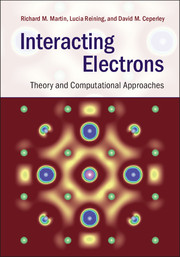Book contents
- Frontmatter
- Dedication
- Contents
- Preface
- Acknowledgments
- Notation
- Part I Interacting electrons: beyond the independent-particle picture
- Part II Foundations of theory for many-body systems
- Part III Many-body Green's function methods
- 9 Many-body perturbation theory: expansion in the interaction
- 10 Many-body perturbation theory via functional derivatives
- 11 The RPA and the GW approximation for the self-energy
- 12 GWA calculations in practice
- 13 GWA calculations: illustrative results
- 14 RPA and beyond: the Bethe–Salpeter equation
- 15 Beyond the GW approximation
- 16 Dynamical mean-field theory
- 17 Beyond the single-site approximation in DMFT
- 18 Solvers for embedded systems
- 19 Characteristic hamiltonians for solids with d and f states
- 20 Examples of calculations for solids with d and f states
- 21 Combining Green's functions approaches: an outlook
- Part IV Stochastic methods
- Part V Appendices
- References
- Index
14 - RPA and beyond: the Bethe–Salpeter equation
from Part III - Many-body Green's function methods
Published online by Cambridge University Press: 05 June 2016
- Frontmatter
- Dedication
- Contents
- Preface
- Acknowledgments
- Notation
- Part I Interacting electrons: beyond the independent-particle picture
- Part II Foundations of theory for many-body systems
- Part III Many-body Green's function methods
- 9 Many-body perturbation theory: expansion in the interaction
- 10 Many-body perturbation theory via functional derivatives
- 11 The RPA and the GW approximation for the self-energy
- 12 GWA calculations in practice
- 13 GWA calculations: illustrative results
- 14 RPA and beyond: the Bethe–Salpeter equation
- 15 Beyond the GW approximation
- 16 Dynamical mean-field theory
- 17 Beyond the single-site approximation in DMFT
- 18 Solvers for embedded systems
- 19 Characteristic hamiltonians for solids with d and f states
- 20 Examples of calculations for solids with d and f states
- 21 Combining Green's functions approaches: an outlook
- Part IV Stochastic methods
- Part V Appendices
- References
- Index
Summary
Summary
In this chapter we examine the two-particle correlation function. Many of its properties are experimentally accessible, such as the macroscopic dielectric function and optical spectra, or the dynamic structure factor and loss function. Formally, it is determined by the Bethe–Salpeter equation and a first useful approximation is the random phase approximation. Comparison with experiment displays the strong and the weak points of the RPA. Its shortcomings motivate the search for corrections, commonly called vertex corrections. We show how better approximations to the BSE can be obtained and how the equation can be solved in practice, and we give some illustrations. A comparison with time-dependent density functional theory completes the chapter.
This chapter is dedicated to the calculation of the two-particle correlation function L, which is one of the central quantities in this book. It contains a wealth of experimentally accessible information: optical spectra, electron energy loss spectra, and the dynamic structure factor that is measured for example by inelastic X-ray scattering, the energy of doubly charged defects, and much more. Moreover, many-body perturbation theory can be formulated in terms of the dynamically screened Coulomb interaction W, which is derived directly from the electron–hole correlation function. The GW approximation is the most prominent example of an approximation based on W. Finally, the total energy can be expressed exactly in terms of L, because the Coulomb interaction vc is a two-body interaction.
The two-particle correlation function is formally given by the Dyson-like Bethe– Salpeter equation derived in Sec. 10.3. The present chapter starts in Sec. 14.1 with a brief reminder of the links between L and measurable quantities, since in this chapter we are interested in the spectra that are derived from L. Some important formal relations are recalled in Sec. 14.2. The simplest approximation for L is the random phase approximation introduced in Sec. 11.2. Section 14.3 is dedicated to the study of spectra calculated in the RPA: which physics is contained in this approximation? What are its strengths and limitations? We will see that optical spectra, for example, often require a description beyond the RPA.
The shortcomings of the RPA motivate the effort to go beyond. The two-particle correlation function contains information about the propagation of two particles, which can be electron–hole pairs, or two electrons or two holes, as explained in Sec. 5.8.
- Type
- Chapter
- Information
- Interacting ElectronsTheory and Computational Approaches, pp. 345 - 388Publisher: Cambridge University PressPrint publication year: 2016



